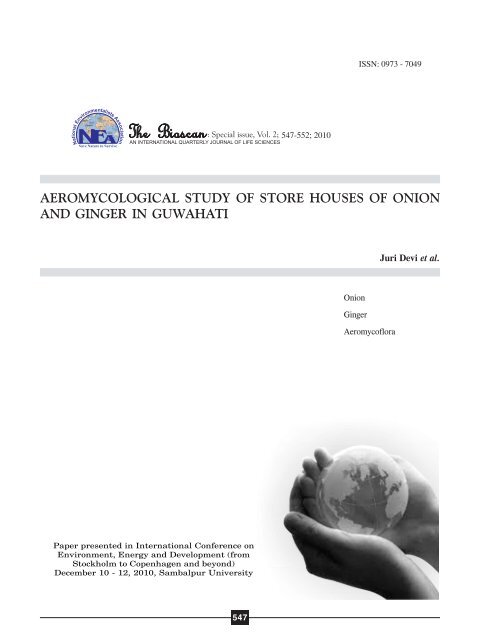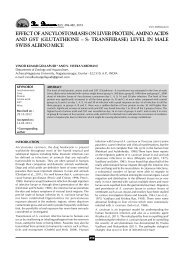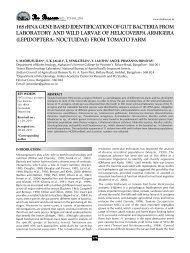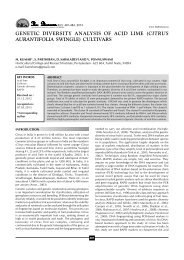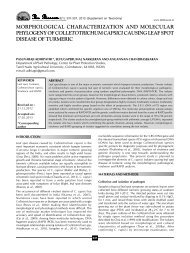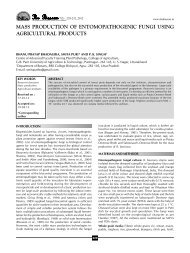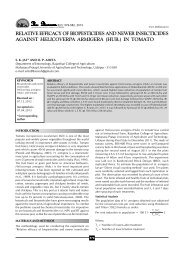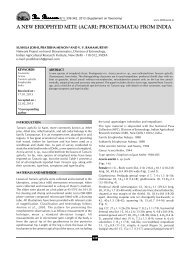full paper - THE BIOSCAN
full paper - THE BIOSCAN
full paper - THE BIOSCAN
You also want an ePaper? Increase the reach of your titles
YUMPU automatically turns print PDFs into web optimized ePapers that Google loves.
ISSN: 0973 - 7049<br />
NSave Nature to Survive<br />
: Special issue, Vol. 2; 547-552; 2010<br />
AEROMYCOLOGICAL STUDY OF STORE HOUSES OF ONION<br />
AND GINGER IN GUWAHATI<br />
Juri Devi et al.<br />
Onion<br />
Ginger<br />
Aeromycoflora<br />
Paper presented in International Conference on<br />
Environment, Energy and Development (from<br />
Stockholm to Copenhagen and beyond)<br />
December 10 - 12, 2010, Sambalpur University<br />
547
NSave Nature to Survive<br />
JURI DEVI, SADHANA MEDHI AND T. C. SARMA*<br />
Department of Botany, Gauhati University, Guwahati - 781 014<br />
E mail: tarunchandrasarma@yahoo.com<br />
ABSTRACT<br />
A survey of indoor aeromycoflora of store houses of onion and ginger was carried out in<br />
Guwahati, Assam, during the period of March, 2009 to August, 2010, employing gravity slides<br />
and gravity petridish methods, with a view to correlating the decay of onion and ginger by the<br />
fungi in their stored conditions. This was being carried out in pursuance with some informal<br />
reports of the wholesellers regarding the spoilage of these two commercially important plant<br />
produce. Some microfungi were isolated belonging to the genera- Alternaria, Aspergillus, Botrytis,<br />
Cercospora, Colletotrichum, Curvularia, Cladosporim, Fusarium, Helminthosporium<br />
,Lasiodiplodia, Mucor, Penicillium, Rhizopus, Trichoderma, Trichothecium, Verticillium.<br />
*Corresponding author<br />
548
STUDY OF ONION AND GINGER<br />
INTRODUCTION<br />
Air is a natural medium for certain very very minute particles including many mycoflora. Investigations on<br />
the aeromycoflora were carried out in order to correlate with the different types of crop diseases in India<br />
viz.,diseases of banana, bajra, citrus, cotton, jowar, rice, sugarcane, wheat and other crops (Padmanabhan<br />
et al., 1953; Sreeramulu and Seshavataram, 1962; Sreeramulu, 1959; Sreeramulu and Ramalingam, 1963,<br />
1964, 1965; Tilak and Kulkarni, 1970, 1972, 1980; Tiwari and Sahu, 1995). Occurrence of aeromycoflora in<br />
the fruit markets were also studied (Sarma and Bhattacharjee, 2001). Airborne mycoflora are largely<br />
determined by topography, meteorological parameters, vegetation and biotic factors including human activities<br />
(Lacey, 1981; Lyon et al., 1984). The mycoflora concentration in the atmosphere are influenced by the<br />
processes involved in their production, release and deposition (Lyon et al.,1984). The present study has been<br />
carried out to screen the mycoflora of air over the store houses of onion and ginger of Guwahati and to find<br />
correlation of occurrence and also the incidence of decay of both onion and ginger in the store houses. Onion<br />
is one of the most important vegetable crops. This important crop is being imported to Assam from different<br />
parts of India. Guwahati is the gateway of North-East India and it is also the commercial capital of N.E<br />
India. The imported onions are mostly stored in different storehouses of Guwahati and the varieties are-<br />
White onion. Red onion and Yellow onion. The fungal deterioration of all these varieties have been observed.<br />
Similarly rhizome of ginger which is also one of the most important spice crop of Assam are also stored in<br />
the different store houses of Guwahati. The important varieties of ginger in N.E India are- Bola, Moran and<br />
Jatia. There were some informal reports of the owners of the store houses that the decay of the rhizome of<br />
ginger in the stored conditions were severe. Keeping in view of this the investigations on the aeromycoflora<br />
and correlation with the decay of onion and ginger were carried out.<br />
MATERIALS AND METHODS<br />
Air samplings were carried out in different store houses of onion and ginger of Guwahati using gravity slides<br />
and gravity petridish methods. In the Czapek’s medium aliquiet of streptomycin was added to inhibit the<br />
bacterial growth. These petridishes were exposed to the air of different store houses at different duration<br />
such as 0, 1, 2 and 3 minutes; and at different heights -0- level(ground level) and 500 cms, 1000 cms and<br />
2000cms above ground level. The experiments were done monthly for one year and 4 replicates were used<br />
for each sampling. The petridishes were incubated for 7 days. The isolates were examined and identified.<br />
For pathogenecity test a loopful of fungal mat was inoculated aseptically to healthy onion and ginger by<br />
making small incision in bulb and rhizome respectivily. The inoculated bulb and rhizome were kept wrapping<br />
in cellophane bags. The progress of spoilage were observed periodically. The data were correlated with<br />
meteorological parameters.<br />
RESULTS AND DISSCUSSION<br />
The mycoflora trapped from the air inside the store houses of onion and ginger were- Alternaria alternata,<br />
A. solani, Aspergillus flavus, A. niger, A. terreus, Cercospora sp., Cladosporium sp., Colletotrichum capsici,<br />
Curvularia lunata, Fusarium oxysporum, F. moniliforme, F. solani, F. zingiberi, Helminthosporium sp.,<br />
Lasiodiplodia theobromae, Mucor mucedo, Penicillium citrinum, Rhizopus stolonifer, Trichoderma sp.,<br />
Trichothecium sp. and Verticillium theobromae.<br />
Species of Alternaria, Colletotrichum ,Lasiodiplodia, Trichoderma and Trichothecium were not available at<br />
1000cms and 2000cms. Petridishes containing media were exposed for 1 minute, 2 minutes and 3 minutes at<br />
different levels and accordingly microfungi were trapped. The fungal spores trapped at different levels and<br />
at different times have been shown in Table 1 and 2.<br />
The most predominant species found in air in store houses of onion were- Aspergillusniger, A. flavus,<br />
Botrytis sp., Fusarium oxysporum, Helminthosporium sp., Trichoderma sp. and Mucor mucedo. On the other<br />
549
JURI DEVI et al.,<br />
Table 1: Showing frequency of occurrence of fungal species at different heights (cms) in the store houses of onion and<br />
ginger<br />
Height (cm)<br />
Fungi 0-level (ground) 500cms 1000cms 2000cms<br />
1. Alternaria alternata + + + + + - - - - - -<br />
2. A. solani + + + + + - - - - - -<br />
3. Aspergillus flavus + + + + + + + +<br />
4. A. niger + + + + + + + +<br />
5. A. terreus + + + + + + + +<br />
6. Botrytis cinerea + + + + + + +<br />
7. Cercospora sp. + + + + + + + - - -<br />
8. Cladosporium sp. + + + + + +<br />
9. Colletotrichum capsici + + + + + - - - - - -<br />
10. Curvularia lunata + + + + + + + + + +<br />
11. F. oxysporum + + + + + + + + + +<br />
12. F.moniliforme + + + + + + + + + +<br />
13. F. solani + + + + + + +<br />
14. F. zingiberi + + + + + + + + + +<br />
15. Helminthosporium sp. + + + + + + +<br />
16. Lasiodiplodia + + + + + + + - - - -<br />
theobromae<br />
17. Mucor mucedo + ++ + + + +<br />
18. Penicillium citrinum + + + + + + +<br />
19. Rhizopus stolonifer + + + + + + +<br />
20. Trichoderma sp. + + + + - - - - - -<br />
21. Trichothecium sp. + + + - - - - - -<br />
22. Verticillium theobromae ++++ ++ + + + +<br />
Exposure time: 1 minute<br />
Table 2: Showing frequency of occurrence of fungal species at different period of exposure - inside the store houses of<br />
onion and ginger<br />
Different period of exposure<br />
Fungi 0 minute 1 minute 2 minute 3 minute<br />
Alternaria alternata — + + + + + +<br />
A. solani — + + + +<br />
Aspergillus flavus — + + + + + + + + +<br />
A. niger — + + + + + + + +<br />
A. terreus — ++ + + + + + + +<br />
Botrytis cineria — + + + + + + + + +<br />
Cercospora sp. — + + + +<br />
Cladosporium sp. — + + + + + +<br />
Colletotrichum capsici — + + + + + +<br />
Curvularia lunata — + + + +<br />
Fusarium oxysporum — + + + + + + + + +<br />
F. moniliforme — + + + + + + + + +<br />
F. solani — + + + + + + + + +<br />
F. zingiberi — + + + + + + + + +<br />
Helminthosporium sp. — + + +<br />
Lasiodiplodia theobromae — — + + +<br />
Mucor mucedo — + + + +<br />
Penicillium citrinum — + + + + + +<br />
Rhizopus stolonifer — + + + + + + + +<br />
Trichoderma sp. — — + + +<br />
Trichothecium sp. — — + + +<br />
Verticillium theobromae — + + + + + +<br />
hand predominant species in the store houses of ginger were- Aspergillus niger, Fusarium oxysporum, F.<br />
solani, F. zingiberi, Lasiodiplodia sp. and Verticillium thebromae.<br />
The concentration of mycoflora was recorded highest from the month of March to October and gradually<br />
decline towards January. Certain genera like Cladosporium and Helminthosporium were predominant even<br />
550
STUDY OF ONION AND GINGER<br />
90<br />
80<br />
70<br />
60<br />
50<br />
40<br />
30<br />
20<br />
10<br />
0<br />
35<br />
30<br />
25.5<br />
70<br />
60.5<br />
55<br />
RED ONION WHITE ONION YELLOW ONION<br />
75<br />
71.4<br />
67<br />
80<br />
78<br />
75<br />
65<br />
62<br />
59<br />
60.559.2<br />
55.5<br />
58<br />
54<br />
46<br />
AA ASF ASN BC FO FS RS<br />
AA- Alternaria alternate; ASF- Aspergillus flavus; ASN- A. niger; BC- Botrytis<br />
cinerea; FO- F. xysporum; FS- F. solani; RS- Rhizopus stolonifer<br />
80<br />
70<br />
60<br />
50<br />
40<br />
30<br />
20<br />
10<br />
0<br />
35<br />
31.5<br />
30<br />
50.4<br />
46.7<br />
40.4<br />
Jatia Bola Moran<br />
60.259.2<br />
53.4<br />
68.4 69<br />
66.3 65.1<br />
60.6<br />
50.5<br />
40.2<br />
36.9<br />
32.8<br />
ASN BC FO FS FZ H<br />
ASN- Aspergillus niger; BC- Botrytis cinerea; FO- Fusarium oxysporum; FS- F. solani; FZ-<br />
F.zingiberi; H- Helminthosporium sp.<br />
in the month of November. It coincides<br />
with the report of Padmanavan et al.<br />
(1953). Curvularia lunata was seen to<br />
occur in gradual seasonal change and it<br />
has also been coinciding with those of<br />
Sreeramulu and Ramalingam (1966).<br />
The present investigation also recorded<br />
the presence of Botrytis sp. responsible<br />
for neck rot of onion bulb which confirms<br />
findings of Maude and Prestly (1977).<br />
Similarly prevalence of Aspergillus sp.<br />
in air of the store houses of onion can be<br />
correlated with the findings of Lee et al.<br />
(2000).The results of the pathogenecity<br />
test have been shown in the Table 3 and<br />
Table 4 and Fig. 1and Fig. 2.<br />
Pathogenecity tests show that all the<br />
trapped fungi from air were not equally<br />
efficient in causing rot of onion and<br />
ginger. Aspergillus sp., Fusarium<br />
oxysporum and Botrytis cinerea were<br />
found efficient in quicker rotting of onion.<br />
Likewise Fusarium oxysporum and F.<br />
solani and F. zingiberi were found to be<br />
associated with rot of ginger. The months<br />
of July, August, September and October<br />
were most favourable for rotting which<br />
coincides with the highest spore load in<br />
the air. Among the varieties of onion,<br />
red onion and white onion are more prone<br />
to rotting. Similarly among the varieties<br />
Table 3: Pathogenecity test in 3 varieties of onion with<br />
trapped aeromycoflora<br />
Isolated fungal pathogen<br />
% of rot after 7 days of incubation<br />
Red White Yellow<br />
Onion Onion Onion<br />
Alternaria alternata 35 30 25.5<br />
Aspergillus flavus 70 60.5 55<br />
A. niger 75 71.4 67<br />
Botrytis cinerea 80 78 75<br />
F. oxysporum 65 62 59<br />
F. solani 60.5 59.2 55.5<br />
Rhizopus stolonifer 58 54 46<br />
Table 4: Pathogenecity test in 3 varieties of ginger with<br />
trapped aeromycoflora<br />
Isolated fungal pathogen % of rot after 7 days of incubation<br />
Jatia Bola Moran<br />
Aspergillus niger 35 31.5 30<br />
Botrytis cinerea 50.4 46.7 40.4<br />
Fusarium oxysporum 60.2 59.2 53.4<br />
F. solani 68.4 66.3 50.5<br />
F.zingiberi 69 65.1 60.6<br />
Helminthosporium sp. 40.2 36.9 32.8<br />
of ginger, jatia and bola are more prone to rotting. Meteorological parameters like temperature and humidity<br />
seem to play vital role for the occurrence of mycoflora in the air of store houses and also the rotting of onion<br />
and ginger.<br />
ACKNOWLEDGEMENT<br />
The authors are very much thankful to Prof. S.P.Bora, Head, Department of Botany, Gauhati University for<br />
551
JURI DEVI et al.,<br />
providing laboratory facilities and Prof S.K.Borthakur,Professor of Botany for inspiring us to undertake this<br />
piece of research work.<br />
REFERENCE<br />
Lacey, J. 1981. The aerobiology of conidial fungi.- In Biology of conidial fungi vol. 1 (Ed. G.T.Cole and<br />
Kendrick), Academic Press, Newyork. pp. 373-415.<br />
Lee, J. T., Bae, D. W., Park, S. H., Shim, C. K., Kwak, Y. S. and Kim, H. K. 2001. Occurrence and<br />
biological control of post harvest decay onion caused by fungi; The Pl. Path, Jr. pp. 141-148.<br />
Lyon, F. L., Framer, C. L. and Eversmeyer. M. G. 1984. Variation of airspora in the atmosphere due to weather<br />
conditions. Grana. 23: 177-181.<br />
Maude, R. B. and Prestly, A. H. 1977. Infection of onions by Botrytis allii. Ann. of Appl. Biol. 85(1): 165.<br />
Padmanabhan, S. Y., Ganguli, D. and Balkrishnan, M. S. 1953. Helminthosporium disease of Rice ll. Source<br />
and development of seedling infection. Ind. Phytopath. 5: 96-105.<br />
Sarma, T. C. and Bhattacharjee, R. N. 2001. Occurrence of Aeromycoflora of Banana fruit markets. J Adv. Pl.<br />
Sci. 3: 59-65.<br />
Sreeramulu, T. 1959. The diurnal and seasonal periodicity of certain plant pathogen in the air. Trans Br. Mycol.<br />
Soc. 42: 177-184.<br />
Sreeramulu, T. and Ramalingam, A. 1963. Spore content of air over paddy fields- ll changes in the field near<br />
Vishakhapatnam from November 1959 to January 1960. Proc. Nat. Acad. Sci., India. 33: 423-428.<br />
Tilak, S. T. and Kulkarni, R. L. 1970. Airspora over sugarcane fields. International Symp. Patho. New Delhi<br />
Tilak, S. T. and Kulkarni, R. L. 1972. Microbial content of air inside and outside the caves at Aurangabad. Curr.<br />
Sci. 23: 850-851.<br />
Tilak, S. T. and Kulkarni, R. L. 1980. Some additions to the fungal flora of the air. Ind. Phytopath. 34: 69-71.<br />
Tiwari, K. L. and Sahu, S. K. 1995. Aeromycological study of Raipur Adv. Pt. Sc. 8(2): 391-396.<br />
552


